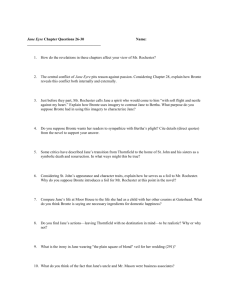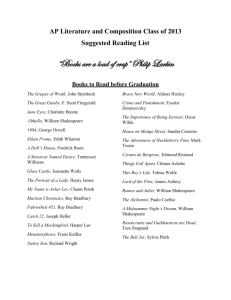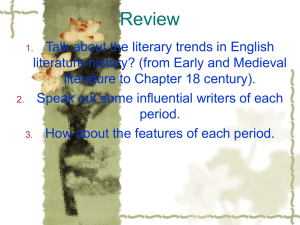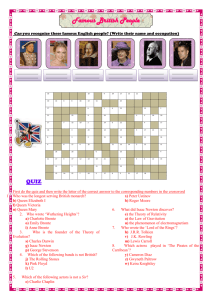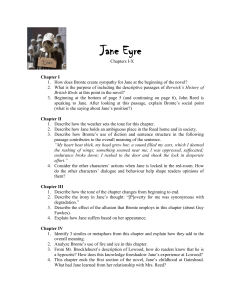Stephan Herman English 151W Professor. Jacobs Is Charlotte
advertisement
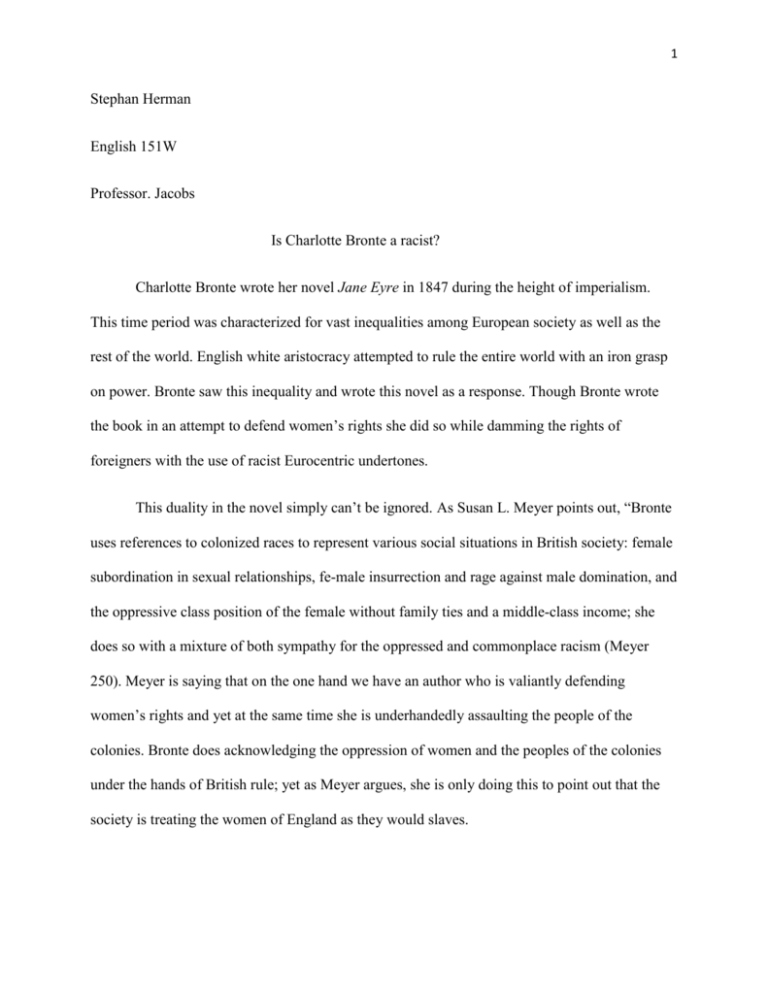
1 Stephan Herman English 151W Professor. Jacobs Is Charlotte Bronte a racist? Charlotte Bronte wrote her novel Jane Eyre in 1847 during the height of imperialism. This time period was characterized for vast inequalities among European society as well as the rest of the world. English white aristocracy attempted to rule the entire world with an iron grasp on power. Bronte saw this inequality and wrote this novel as a response. Though Bronte wrote the book in an attempt to defend women’s rights she did so while damming the rights of foreigners with the use of racist Eurocentric undertones. This duality in the novel simply can’t be ignored. As Susan L. Meyer points out, “Bronte uses references to colonized races to represent various social situations in British society: female subordination in sexual relationships, fe-male insurrection and rage against male domination, and the oppressive class position of the female without family ties and a middle-class income; she does so with a mixture of both sympathy for the oppressed and commonplace racism (Meyer 250). Meyer is saying that on the one hand we have an author who is valiantly defending women’s rights and yet at the same time she is underhandedly assaulting the people of the colonies. Bronte does acknowledging the oppression of women and the peoples of the colonies under the hands of British rule; yet as Meyer argues, she is only doing this to point out that the society is treating the women of England as they would slaves. 2 Charlotte Bronte’s main character Jane is her ideal of womanhood. Jane represents the personification of purity, integrity, prudence, determination and most important Christianity; Jane is essentially the perfect English woman. Beyond that, Jane comes from a humble background and in the novel despite all of her adversities in life she is able to become the equal to a very powerful English man. This is a very refreshing feminist approach to the English literature of the time. This central theme that women are fully capable of taking care of themselves permeates throughout the novel: Jane at one point is teaching a classroom on her own and supporting her cousins through her own wealth. It is incredible to think that a founder for women’s rights could be so blind to the mistreatment of her fellow men and women. Yet in her portrayal of Bertha we first see hints of racist undertones. If Jane represents all that is good in English society we can perhaps view Berthas portrayal as all that is wrong. She shares many similarities to Jane, but there are aspects many unsavory aspects about her as well. We see Rochester describe her as “a fine woman…tall, dark, and majestic. (Bronte 343). While Rochester is acknowledging that Bertha is beautiful, by calling her dark and majestic, he is essentially saying she is beautiful, but a foreigner as well. Adding to this point he also says that “Her family wished to secure me because I was of a good race” (Bronte 343). This line follows his description of Bertha and it is clearly showing Rochester’s belief that his wife is below him because she is “dark” and merely wishes to marry a white English man. We can find many these examples of Rochester’s obvious distain for his wife’s heritage: “I found her nature wholly alien to mine; her tastes obnoxious to me; her cast of mind common, low, narrow and singularly uncapable of being led to anything higher, expanded to anything larger (Bronte 344). This line goes beyond just a dislike of his wife; we are seeing a distain for 3 her culture in general. He even says so when he admits that he “was not sure of the existence of one virtue in her nature” (Bronte 343). In this line we can take nature to mean heritage or upbringing. It can be seen that Rochester’s opinions of his wife are racist, but this does not mean Bronte shares these obnoxious viewpoints. After all, she is trying to portray a class warfare novel. In so doing, perhaps she means to vilify Rochester as a racist aristocrat and show the villainy of the aristocracy. We do however see similar viewpoints shared by the character St. John. St. John is a lower class member of society who has similarly questionable views of the colonies: “My hopes of being numbered in the band who have merged all ambitions in the glorious one of bettering their race--of carrying knowledge into the realms of ignorance--of substituting peace for war--freedom for bondage--religion for superstition--the hope of heaven for the fear of hell? Must I relinquish that? It is dearer than the blood in my veins. It is what I have to look forward to and to live for” (Bronte 417-418). In this passage St. John is telling Jane he cannot give up his so called noble pursuit because he must educate and save the foreign heathens from their own “ignorance”. A lower class male is sharing the opinion that the colonies are in need of enlightenment. In these two male characters we see the emergence of a vilification and distain for foreigners. If we view this narrative as merely an argument for feminism then perhaps one can view the statements of these characters as merely the true ignorance of a male dominated society. One could find merit in this interoperation if the character of Jane Eyre did not share similar feelings toward the colonies themselves. 4 When Jane first observes Bertha we see hints of a racist undertone. Jane describes Bertha as “Fearful and ghastly” because her face appears to be “discolored”, “savage”, and “purple” (Bronte 317). We can see that Jane, through Bronte, is equating a visage of evil through being discolored or not white. Rochester even alludes to this when he says “Ghosts are usually pale, Jane” (Bronte 317). Bronte is making a specific point here to note that this so called monster is dark and thus “savage”. Going beyond this description of Bertha we see Jane’s racist tendencies come out when she comments about St. Johns pilgrimage to India. Jane says St. John would be better suited for “scenes of strife and danger” and “the Himalayan ridge, or Caffre bush, even the plague-cursed Guinea Coast swamp, would suit him better” than a “domestic life” (Bronte 438). In this passage we see that Jane views places like the Guinea Coast and the Africa bush, or the Caffre bush as she calls it, as places of danger where only the valiant can and should go. Bronte through Jane is projecting an image of English tranquility compared to the ‘savage” world. This projecting or symbolism is one of the strongest aspects of Bronte’s writing style. And in Bronte’s depictions of the environments we can even find a racist undertone. The way she portrays the East Indies themselves can be called to question: "It was a fiery West Indian night; one of the description that frequently precede the hurricanes of those climates. Being unable to sleep in bed, I got up and opened the window. The air was like sulphur streams - I could find no refreshment anywhere. Mosquitoes came buzzing in and hummed sullenly around the room; the sea, which I could hear thence, rumbled dull like an earthquake- black clouds were casting up over it; the moon was setting in the waves, broad and red, like a hot cannon-ball…I was physically influenced by the atmosphere....This life… is hell” (Bronte 346). 5 This passage is loaded with unpleasant imagery of the West-Indies. Perhaps the most telling is Rochester exclaiming that a life in the West-Indies “is hell”. As Meyer points out “in Jane Eyre, Bronte consistently associates unhealthy, conta-gious environments with racial "otherness" and with oppression, that "poi-soned exhalation of the East” (Meyer 263). Meyer is showing that Bronte views the colonies as poison to England. We see this message explained in the following passage when Rochester, contemplating suicide finds that “A wind fresh from Europe blew over the ocean and rushed through the open casement: the storm broke… and the air grew pure. I then framed and fixed a resolution… I saw hope revive… Go said hope and live again in Europe” (Bronte 347). In this passage we see Rochester feels his only chance of salvation is to leave this “savage” land behind and go to Europe where he may again find hope and salvation. Although Bronte may have been trying to criticize the social system for how unfair it was to women and lower classes of England she did so with little regard to the peoples of foreign identity. As Meyer points out, “Bronte uses the analogy in Jane Eyre for her own purposes, to signify not shared inferiority but shared oppres-sion. (Meyer 251) Shared oppression is the key here. It’s not that White women and lower class Englishman were inferior to the white aristocracy they were just treated that way. We can see that throughout the novel Bronte does not defend the colonies; rather she merely alludes to how unpleasant they are. Anytime something is perceived as evil or “hellish” it is related directly to the foreign lands. In Bronte’s mind it is the fact that Jane is subjected to this kind of treatment that must be changed, not the treatment in general. In the pursuit of equality Bronte portrays her racist beliefs. As Bronte herself states through Jane “prejudices, it is well known, are most difficult to eradicate from the heart whose 6 soil has never been loosened or fertilised by education: they grow there, firm as weeds among stones. (Bronte 381) Bronte did not know any better. She was raised in a society that held these beliefs to be matter of fact. It becomes obvious as to why Jean Rhys would find this book to be offensive and ignorant. In confronting Bronte’s misguided beliefs, Rhys helped to create a postcolonial theory that to this day confronts racist undertones that are falsely accepted in famous and influential pieces of literature like Jane Eyre. 7 Works Cited Bronte, Charlotte, Jane Eyre. 3rd Ed. Michael Mason. London: Penguin Books Ltd, 1996. Print Meyer, Susan. L, “Colonialism and the Figurative Strategy of Jane Eyre, Victorian Studies Vol. 33, No. 2 (Winter,1990), 247-268. JSTOR, Web May 09, 2011

